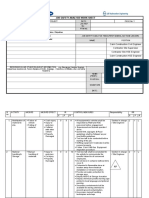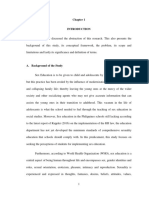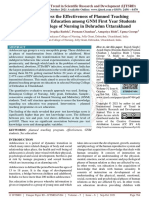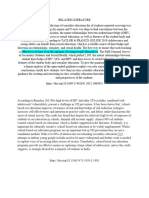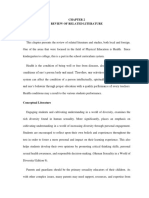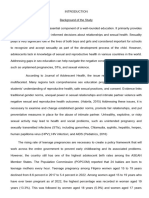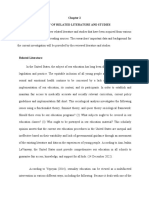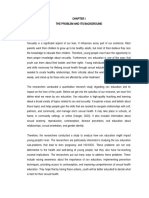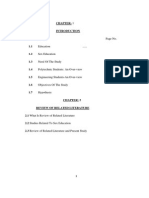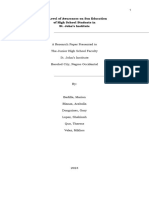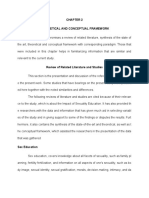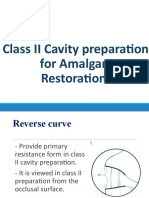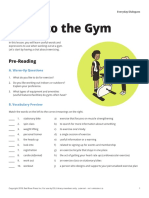Professional Documents
Culture Documents
The Teaching of Comprehensive Sexuality Education: Basis For A Guidance Program On Sexuality Awareness
The Teaching of Comprehensive Sexuality Education: Basis For A Guidance Program On Sexuality Awareness
Original Title
Copyright
Available Formats
Share this document
Did you find this document useful?
Is this content inappropriate?
Report this DocumentCopyright:
Available Formats
The Teaching of Comprehensive Sexuality Education: Basis For A Guidance Program On Sexuality Awareness
The Teaching of Comprehensive Sexuality Education: Basis For A Guidance Program On Sexuality Awareness
Copyright:
Available Formats
Volume 9, Issue 4, April – 2024 International Journal of Innovative Science and Research Technology
ISSN No:-2456-2165 https://doi.org/10.38124/ijisrt/IJISRT24APR209
The Teaching of Comprehensive Sexuality
Education: Basis for a Guidance Program on
Sexuality Awareness
MARLON A. MAÑAGO
St. Louise de Marillac, College of Sorsogon
Abstract:- The government has acknowledged the educate students on their sexual health and fill them with all
necessity for a thorough approach to sexuality education. the necessary information to be able to mitigate and eradicate
Incorporating it into the curriculum is one way to these issues and their overall development.
progressively give young people the power to make
educated decisions. With this in mind, this study Osadolor UE et al. (2022) stated that sexual behavior
investigated the extent to which comprehensive sexuality during adolescence fundamentally steers the future life of
education is taught to Grade 10 students, as well as the both girls and boys, and it should be guided by appropriate
factors that typically influence these students' sexuality. education. Ramírez-Villalobos, D. et al. (2021) schools are an
The students' perceptions of the current benefits and ideal place to strengthen adolescents’ sexual knowledge and
drawbacks of comprehensive sexuality education were modify their behavior, guiding them to exercise responsible
elicited, resulting in their appreciation of the contribution sexuality. To adequately address the unique needs and rights
of school initiatives to their reawakening of human of teenagers, opportunities must be expanded.
sexuality. The assessment results from the students
became an input in the proposed school-based guidance Comprehensive sexuality education (CSE) is a
program on sexuality education awareness. curriculum-based process of teaching and learning about the
cognitive, emotional, physical, and social aspects of
Keywords:- Comprehensive Sexuality Education, Sexuality sexuality. The Republic Act 10354 Responsible Parenthood
Education Awareness, Reproductive Health, Knowledge, and Reproductive Health Act of 2012) and the RP-RH Act of
Skills, and Attitudes on CSE. 2012, are two laws, that govern comprehensive sexuality
education in the Philippines. By this national policy, the
I. INTRODUCTION Philippine Government is required to satisfy all the needs of
Filipino citizens about responsible parenthood and
According to the World Health Organization (WHO) the reproductive health.
general health and well-being of people, couples, and
families, as well as the social and economic development of With the emerging issues concerning young people in
societies, depend on their sexual health. When regarded sexuality, it is crucial to provide appropriate education to our
positively, sexual health necessitates a positive and respectful learners. Thus, this study aims to assess the knowledge of
attitude toward sexuality and romantic relationships, as well adolescent learners about sexuality to create an appropriate
as the ability to enjoy joyful and secure sexual experiences program to promote awareness to hopefully mitigate, if not
free from compulsion, prejudice, and violence. remove, the impeding issue of sexuality.
Ages 10 to 19 are considered adolescent years, the II. METHODOLOGY
transitional period between childhood and maturity according
to WHO. Adolescence is a crucial stage where a lot of sudden A. Samples
changes happen. Adolescents grow quickly in their physical, A total of 40 Grade 10 students enrolled at Magallanes
mental, and behavioral development. Hence, they need to National High School ages 15-17 years old were the
acquire the necessary lifelong skills to be an able adult. respondents of this study. These students are in the
According to Csikszentmihalyi, M. (2023) Young individuals transitional period between childhood and maturity and likely
go through many physical and social changes, frequently have undergone a lot of changes and realizations. Thus, they
making it hard for them to know how to act. Understanding are suited to be studied to know the extent of teaching CSE in
the transformation that they go through requires being the curriculum.
sensitive to the variety of emotions they feel, puberty being
one of the most significant. Additionally, Hegde A. et al. B. Sampling Procedure
(2022) stated that adolescence is a time when people tend to To reduce the bias involved in the sample, compared to
take more risks, particularly sexual risks, which can have other methods of sampling, participants were selected
serious repercussions like unwanted pregnancy or STIs. This through random sampling. This is used to have a fair method
shows how crucial sexuality education is. Thus, all need of sampling to achieve well-informed data regardless of their
proper comprehensive sexuality education to promote and differences.
IJISRT24APR209 www.ijisrt.com 176
Volume 9, Issue 4, April – 2024 International Journal of Innovative Science and Research Technology
ISSN No:-2456-2165 https://doi.org/10.38124/ijisrt/IJISRT24APR209
C. Instruments III. RESULTS AND DISCUSSION
The researchers utilized a self-made questionnaire to
gather the data to answer the problems outlined in the study. This study has generated the following significant
It is intended to gather information on the extent of teaching results:
comprehensive sexuality education among Grade 10 students.
The tool was subjected to construct and content validity. Two A. Extent of Teaching Comprehensive Sexuality Education
designated guidance counselors were tapped to check the The idea that Comprehensive Sexuality Education
content of the tool used. (CSE) be taught in school has gained a favorable affirmation
from the school stakeholders. For them, CSE is an important
The tool that the researchers utilized was the Five-point part of student education being a holistic approach to
Likert Scale contained within the questionnaire. Five choices sexuality and sexual health which covers topics from puberty,
were presented, which were indicated by their level. The contraception, sexual orientation, and gender identity to
numbers representing each level or degree were the basis for healthy relationships, sexual health, and consent.
identifying the mean of the answers in each question.
Table 1 shows the extent of teaching the CSE in terms
D. Data Collection of honing the contents among the learners. Discussing the
The questionnaire was used to collect data from the forms and types of a healthy relationship is to a “great extent”
students to whom Comprehensive Sexuality Education had in the school scenario. This indicator has 4.4 as the obtained
been taught. The questionnaire went through content validity mean.
and reliability testing before data collection. The qualitative
data collected in this study was systematic and helped the The table also shows that addressing sexual and
researcher to discuss the findings easily. The information reproductive health issues has been discussed with the
from the questionnaire was analyzed by coding and emerging students, with 4 as the mean. This implies that issues
themes. concerning sexual health are in a “great extent” during the
teaching and learning process.
The respondents were reminded that their participation
in the study was voluntary. The researchers dealt with the Additionally, with a 3.95 obtained mean, the table shows
information gathered professionally and confidentially. The that emphasizing the emotional and psychological aspects of
respondents were asked to complete the questionnaire sexuality has been an integral part of the lesson flows. This is
according to which best applies to them. “great extent” in their lessons and thus encompasses areas
such as self-esteem, body image, and coping with emotional
E. Data Analysis challenges related to sexuality and relationships.
The researcher employed descriptive statistical tools to
find the answers to the posed questions in this study. The table also shows that concepts of external factors
that influence one’s sexual and reproductive behaviors are
To interpret the collected data, they were first discussed during the teaching and learning engagement. With
summarized and organized. After this, they were subjected to a mean of 3. 65 this indicates that topics related to these to is
appropriate statistical treatment such as frequency count, in “great extent” therefore there is a demonstration or
mean, and thematic analysis. To determine the extent of presentation of these concepts during the educational
teaching comprehensive sexuality education as assessed by engagement.
the respondents the mean and scale below were used:
Lastly, with a mean of 3.23, the table shows how topics
4.60 – 5.00 Very Great Extent such as consent, safe sex practices, and gender diversity, are
3.60 – 4.59 Great Extent typically integrated during the teaching and learning
2.60 – 3.59 Moderately Extent engagement. While they are addressed to some extent, it is to
1.60 – 2.59 Low Extent a "moderate extent" in the teaching process and there may be
1.00 – 1.59 Very Low Extent room for improvement or further emphasis on these topics in
the teaching and learning activities.
To determine the different factors that influence
respondents about sexuality scale below was used: Overall, with an average of 3.85, the extent of teaching
comprehensive sexuality education in terms of honing
4.60 – 5.00 Strongly Agree content is “great extent” which suggests that a more relatively
3.60 – 4.59 Agree strong and effective incorporation of comprehensive
2.60 – 3.59 Undecided sexuality is needed in honing content about comprehensive
1.60 – 2.59 Disagree sexuality education.
1.00 – 1.59 Strongly Disagree
To determine the respondent's assessment about the
advantages and disadvantages of comprehensive sexuality
education the data collected were translated, summarized,
organized, and categorized into themes.
IJISRT24APR209 www.ijisrt.com 177
Volume 9, Issue 4, April – 2024 International Journal of Innovative Science and Research Technology
ISSN No:-2456-2165 https://doi.org/10.38124/ijisrt/IJISRT24APR209
Table 1: Extent of Teaching Comprehensive Sexuality Education in Terms of Honing Contents
Indicators Weighted Mean Description
1. Concepts of external factors that influence one’s sexual and reproductive behaviors
3.65 Great Extent
are discussed during the teaching and learning engagement.
2. Topics such as consent, safe sex practices, and gender diversity, are typically 3.23 Moderately
integrated during the teaching and learning engagement. Extent
3. Addressing sexual and reproductive health issues (including, but not limited to sexual
and reproductive anatomy and physiology, puberty and menstruation; reproduction, 4
Great Extent
contraception, pregnancy, and childbirth; STIs, including HIV and AIDS) has been
discussed with the students
4. Discussing healthy relationships (including communication, consent, respect,
4.4
and conflict resolution. Teach students about different types of relationships, such as Great Extent
friendships, romantic, and family relationships) has been talked about in the school
5. Emphasizing the emotional and psychological aspects of sexuality, including
self-esteem, body image, and coping with emotional challenges related to sexuality and 3.95 Great Extent
relationships has been integral in the lesson flows.
Average 3.85 Great Extent
Table 2 contains the extent of CSE in terms of Honing With an obtained mean of 3.78, it is a “great extent” that
Skills. Herein, with 4.58 as the obtained mean CSE instills a students have developed trust and open communication,
sense of self-worth and self-respect toward students which enabling students to share their thoughts, concerns, and
implies that it is a “very great extent”. questions without fear of judgment. This is crucial in creating
an environment where individuals can explore and
In terms of the practice of sexual hygiene, the table understand their sexuality.
shows that it is “great extent” with an obtained mean of “4”
which suggests that behaviors, such as changing underwear Lastly, with an obtained mean of 3. 75, the table shows
regularly and washing intimate parts, are likely being that skills such as articulating thoughts and feelings related to
followed by the students based on the provided information. sexuality clearly and respectfully have been “great extent”
This means a positive assessment of students' engagement in among students. This means that students have a fair skill in
sexual hygiene practices. conveying information accurately to ensure understanding
and promote open dialogue.
The table also shows other skills honed by CSE like
listening and understanding others' perspectives on sexual Overall, the listed skills honed by CSE in students have
health and relationships. With an obtained mean of 3.88, it obtained a mean of 4 which is a “great extent”. This implies
implies that CSE according to the respondents has been “great that respondents perceive the teaching of comprehensive
extent” in promoting inclusivity in the context of recognizing sexuality education as effective in honing skills, but further
and respecting diverse cultural backgrounds, values, and development is needed because this not only contributes to
beliefs involves a holistic approach that considers every their well-being but also prepares them to engage responsibly
aspect of an individual's identity and creates an environment and respectfully in the broader societal context.
where everyone feels valued and understood.
Table 2: Extent of Teaching Comprehensive Sexuality Education in Terms of Honing Skills
Indicators Weighted Mean Description
1. Practice sexual hygiene (such as changing underwear regularly, washing 4
Great Extent
intimate Parts, etc.…) has been adhered to by the students. "
2. Can articulate thoughts and feelings related to sexuality clearly and 3.75
Great Extent
respectfully.
3. Adept at listening and understanding others' perspectives on sexual health and
3.88
relationships and promoting inclusivity by acknowledging and respecting diverse Great Extent
cultural backgrounds, values, and beliefs.
4. Make informed decisions about their sexual health and relationships and
emphasize the qualities of healthy relationships, such as trust, communication, 3.78
Great Extent
equality, and mutual support. Encourage students to seek and nurture such
relationships.
5. Instill a sense of self-worth and self-respect, helping students make choices that
4.58 Very Great Extent
align with their values and goals.
Average 4 Great Extent
IJISRT24APR209 www.ijisrt.com 178
Volume 9, Issue 4, April – 2024 International Journal of Innovative Science and Research Technology
ISSN No:-2456-2165 https://doi.org/10.38124/ijisrt/IJISRT24APR209
Attitudes influence the overall learning environment. The table clearly shows how teachers reinforce healthy
Positive attitudes contribute to a supportive and respectful and positive values about bodies, puberty, relationships, sex,
atmosphere where students feel comfortable exploring and and family life. With a weighted mean of 3.78, it is a “great
understanding various aspects of sexuality. As shown in Table extent” in the learning environment. This implies that
3 are different attitudes that help in developing students have a full view of diverse body types and that they
comprehensive sexuality education. With 4.25 as the are promoting acceptance and appreciation for different
weighted mean, the table shows that students manifest respect shapes, sizes, and appearances.
for one ‘s gender orientation. It implies that students learned
how students should respect and acknowledge the diversity of Lastly, the table shows that teachers have imparted a
sexual orientations, gender identities, and cultural deeper sense of empathy toward others with a weighted mean
backgrounds to is “great extent”. This attitude embraces of 3.43. This suggests that topics skills such as heightened
diversity and ensures that all individuals feel represented and empathy that involve actively listening without judgment,
valued. being open to different viewpoints, and acknowledging
diverse experiences are “moderately extent”. It also entails
Attitude about self-reflection is also shown in the table cultivating a non-biased and non-judgmental attitude to create
with a 4.2 as a weighted mean, which implies that engaging a safe space for individuals to express their thoughts and
in self-reflection and understanding values, preferences, and concerns about sexuality.
boundaries in relationships is “satisfactorily evident”.
Overall, with a weighted mean of 4, it implies that the
The table also shows the extent how which students extent of teaching CSE in honing skills is “great extent”.
developed an understanding of the diversity of sexual However, there is still room for improvement by encouraging
orientations, gender identities, and relationship dynamics. comprehension, respect, making educated decisions, and the
Accordingly, this is a “great extent” with a weighted mean of development of vital life skills. Teaching comprehensive
3.8. This means that effective sexuality education is based on sexuality education helps improve attitudes toward sexuality.
an understanding of the diversity seen in sexual orientations,
gender identities, and relationship dynamics.
Table 3: Extent of Teaching Comprehensive Sexuality Education in terms of Honing Attitudes
Indicators Weighted Mean Description
1. Manifest respect for one ‘s gender orientation. 4.25 Great Extent
2. Understand the diversity of sexual orientations, gender identities, and 3.8
Great Extent
relationship dynamics.
3. Develop a deeper sense of empathy towards others, recognizing and 3.43
Moderately Extent
appreciating the diversity of experiences and perspectives related to sexuality.
4. Reinforces healthy and positive values about bodies, puberty, relationships, 3.78
Great Extent
sex, and family life.
5. Engage in self-reflection, understanding their values, preferences, and
4.2 Great Extent
boundaries in relationships.
Average 3.82 Great Extent
B. The Factors that Influence Grade 10 Students About and clearly. This encourages open communication about
Sexuality feelings and emotions to establish a foundation for healthy
The implementation of CSE has been intricately shaped emotional expression.
by different factors that significantly influence students'
experiences and outcomes. Among these factors are as The emotional well-being, including mental health, of
follows: student perception, teacher dynamics, cultural the students is also displayed in the table with a weighted
influences, and environmental conditions which play pivotal mean of 4.13, they “agree” that this may have an impact on
roles in shaping the educational journey. Here, we're trying to their capacity to discuss delicate subjects. This implies that
understand how they affect students' academic performance promoting empathy, providing a safe space for discussion,
and general well-being. To establish an inclusive and and acknowledging the emotional nature of sensitive topics
productive learning environment we can start by can all enhance students' educational experiences in general.
acknowledging and addressing these elements.
The table also shows that students “agree” with the idea
Table 4 clearly shows that one factor that influences that students' openness to learning CSE contents without any
students about CSE is their readiness for certain sexuality malice yields better implementation of CSE. This indicator
topics. With a weighted mean of 4.15, they “agree” that obtained a 3.93 weighted mean which implies that when
students' age and stage development may affect their students are receptive to CSE without any negative intent, it
understanding of CSE. Introducing age-appropriate contributes to a more effective execution of the program.
information about body parts, proper names, and
understanding appropriate and inappropriate touch simply
IJISRT24APR209 www.ijisrt.com 179
Volume 9, Issue 4, April – 2024 International Journal of Innovative Science and Research Technology
ISSN No:-2456-2165 https://doi.org/10.38124/ijisrt/IJISRT24APR209
Additionally, the table shows that students also “agree” The result further supports the findings of Upadhyay, U.
with the idea that students’ attitudes and beliefs about D., & Hindin, M. J. (2006) which state that there is a crucial
sexuality can impact their engagement with the curriculum significance that friends play in adolescents' lives given the
and acquisition of vital facts about CSE, with a weighted conflicting influences that they face.
mean of 3.9. This suggests that students' attitudes and beliefs
about sexuality play a crucial role in their engagement with Collectively, the students “agree” with students'
the CSE curriculum. openness, peer influence, attitude and beliefs, age and
developmental readiness, and emotional well-being as factors
Lastly, according to the table students “agree” with the that affect them in the acquisition of information about
notion that peer influences opinions and misconceptions can sexuality education.
impact student's perception and understanding of sexuality.
This suggests that students acknowledge their peer views and
comprehension of certain sexual topics.
Table 4: Student-Related Factors Influencing Sexuality
Indicators Weighted Mean Description
1. Students' openness to learn CSE contents without any malice yields better 3.93
Agree
implementation of CSE
2. Peer influences opinions and misconceptions can impact student's perception and 3.88
Agree
understanding of sexuality.
3. Student’s attitudes and beliefs about sexuality can impact their engagement with the 3.9
Agree
curriculum and acquisition of vital facts about CSE.
4. Student’s age and development stage influence their readiness for certain sexuality 4.15
Agree
education topics.
5. Students' emotional well-being, including mental health, can influence their ability
4.13 Agree
to engage with sensitive topics.
AVERAGE 3.99 Agree
Table 5 shows the different teacher-related factors The table also shows that a diverse approach to teaching
related to the successful implementation of comprehensive is a factor that affects the implementation of CSE. With a
sexuality education, creating an environment that promotes weighted mean of 3.78, students “agree” with the idea that it
understanding, respect, and informed decision-making can help accommodate differences in student's learning
among students. The table shows that students “agree” that styles. This also reflects students’ preference for a student-
teachers ‘promotion, recognition, and respect for gender centered approach to education, where the focus is on
identity and sexual orientation diversity influence sexuality adapting teaching methods to meet the individual needs and
education. This indicator has a 4.43 weighted mean. This preferences of students. Lastly, the table shows that students
suggests that students “agree” that there is a need for an “agree” that teachers should possess a certain favorable
inclusive curriculum that acknowledges and respects the expertise on comprehensive sexuality education. This
diversity of individuals. indicator has a weighted mean of 3.75, which suggests that
students believe that when a teacher is an expert it builds trust
Meanwhile, students “agree” on the idea that teachers’ between teachers and students. When students trust that their
views on sexuality create a great impact on perceptions of the teacher is knowledgeable and supportive, they are more likely
topic. This indicator has a weighted mean of 4.08 which to seek guidance and clarification on sensitive topics.
implies that students view teachers not just educators; they
see them as role models whose views substantially contribute Overall, with a weighted mean of 3.98, students “agree”
to the overall understanding and development of sexuality. with the following indicator that affects or influences them
regarding sexuality education: Teacher’s mastery and
Another factor as shown in the table is the teacher's expertise on CSE topics, teacher’s view about CSE, teacher’s
mastery of the contents in the CSE Curriculum. This indicator recognition and respect for different sexuality and their
has a weighted mean of 3.9. This implies that students “agree” diverse approach in teaching CSE.
with the idea that a teacher’s mastery of topics is essential for
effective instruction, accurate information dissemination, and
creating a positive and impactful learning experience for
students.
IJISRT24APR209 www.ijisrt.com 180
Volume 9, Issue 4, April – 2024 International Journal of Innovative Science and Research Technology
ISSN No:-2456-2165 https://doi.org/10.38124/ijisrt/IJISRT24APR209
Table 5: Teacher-Related Factors Influencing Sexuality
Indicators Weighted Mean Description
1. Teachers who are adept in the contents of the CSE Curriculum can deliver the 3.9
Agree
topics with ease and mastery.
2. Teachers’ views on sexuality create a great impact on perceptions of the topic 4.08 Agree
3. Teachers have to possess a certain favorable expertise on comprehensive
3.75
sexuality education which is essential in clarifying doubts and addressing Agree
personal concerns among students
4. Teachers ‘promotion, recognition, and respect for gender identity and sexual
orientation diversity in comprehensive sexuality education - an inclusive
4.43 Agree
curriculum creates a positive impact in the realization of the goals of
comprehensive sexuality education
5. A diverse approach to teaching can help accommodate these differences in
student's learning styles. Some may learn better through discussions, while others 3.78 Agree
prefer written materials or multimedia
AVERAGE 3.98 Agree
Table 6 shows the different environment-related factors environment at all levels in our society significantly
affecting sexuality education. One factor is the availability influences the availability and quality of CSE programs.
and accessibility of healthcare services which includes sexual
and reproductive services. With a weighted mean of 4.28, Another factor shown in the table, with a weighted mean
students “agree” that integration of comprehensive sexuality of 3.98 is the socioeconomic factor. Students “agree” that
education with accessible and supportive healthcare services marginalized groups, often facing economic challenges, may
ensures that individuals not only acquire knowledge but also struggle to access CSE resources due to financial constraints.
have the resources and support systems necessary to make
informed and healthy choices throughout their lives. Lastly, the presence of social media platforms
complements the students’ learning of sexuality as a factor
Another factor shown in the table is the general health that influences sexuality education. This indicator has
and well-being of a community. Herein, it highlights the need obtained a 3.95 weighted mean, which suggests that students
for CSE by including issues related to sexuality. With a “agree” that educators and students should critically evaluate
weighted mean of 4.25, this suggests that students “agree” information, promote reliable sources, and foster a respectful
that if there are barriers to healthcare access, CSE becomes and inclusive online learning environment.
even more critical in providing essential information and
empowering individuals. Overall, the indicated environment-related factors that
influence sexuality education have an average weighted mean
The table also shows that the presence or absence of of 4.09 which implies that students “agree” that social media,
supportive legal and policy frameworks at the national, state, presence and absence of legal and policy frameworks,
or local levels can influence the availability and quality of socioeconomic factors, availability of healthcare services,
CSE programs. This indicator obtained a 4.03 weighted mean and general health and well-being of a community have
which suggests that students “agree” that the legal and policy affected the acquisition and acceptance of information on
comprehensive sexuality education.
Table 6: Environment-Related Factors Influencing Sexuality
Indicators Weighted Mean Description
1. The presence of social media platforms complements the students’ learning 3.95
Agree
of sexuality.
2. The presence or absence of supportive legal and policy frameworks at the
national, state, or local levels can influence the availability and quality of CSE 4.03
Agree
programs. Strong policies can provide guidance and funding, while restrictive
laws can hinder implementation.
3. Socioeconomic factors that are often linked to culture can affect access to
3.98
CSE resources and information. In some cultures, marginalized groups may Agree
have limited access to CSE.
4. The availability and accessibility of healthcare services, including sexual and
4.28
reproductive health services, can affect the overall effectiveness of CSE. These Agree
services should complement the education provided.
5. The general health and well-being of a community, including issues like teen
pregnancy rates and sexually transmitted infections, can highlight the need for 4.25 Agree
effective CSE and influence its implementation.
Average 4.09 Agree
IJISRT24APR209 www.ijisrt.com 181
Volume 9, Issue 4, April – 2024 International Journal of Innovative Science and Research Technology
ISSN No:-2456-2165 https://doi.org/10.38124/ijisrt/IJISRT24APR209
Table 7 shows some culture-related factors that affect The table also shows that myths about sexuality hinder
sexuality education. As reflected in the table one of the factors students from accepting the basic facts about gender and sex.
that affects students in sexuality education is the level of This indicator has obtained a weighted mean of 3.93, which
parental and community involvement and support for CSE. implies that students “agree” with the idea that myths may
This indicator has a weighted mean of 4.28. this implies that limit students' access to comprehensive information about
students “agree” that with the full support of parents and sexual health and practices leading to gaps in their
communities, there is a greater chance that students will have understanding of CSE.
consistent messaging between home and school.
Lastly, the indicator with a weighted mean of 3.65 is
Another factor is cultural differences in communication societal taboos and stigma create barriers to open discussion.
styles. This indicator has obtained a 4.13 weighted mean, The result implies that students are “undecided” about
which suggests that students “agree” that effective societal taboos that may affect sexuality education. However,
communication in CSE requires adaptability and flexibility. this may deter individuals from seeking information on
Many communities are culturally diverse, and individuals reproductive health, contraception, and sexually transmitted
within a community may come from various cultural infections as it is deemed forbidden to talk about. This lack of
backgrounds. Thus, teachers/facilitators should be willing to knowledge can cause serious health consequences.
adjust their communication style based on the cultural
context. Overall, with an average weighted mean of 3.99
students “agree” on the different culture-related factors
Also, included in the table with a weighted mean of 4 affecting sexuality education such as myths about sexuality
are religious beliefs that affect students’ perspective and education, religious beliefs, societal taboos and stigma,
receptiveness to sexuality education. Students “agree” with cultural differences, and involvement of parents and
this indicator such that students from various religious community.
backgrounds may have different perspectives on sexuality.
This implies recognizing and respecting diverse beliefs may This result further supports the findings of Chavula, et.
provide an understanding of their specific needs and promote al., (2022) that social and cultural factors influence the
open dialogue that allows students to explore their questions implementation and integration of CSE into educational
within the context of their religious values. systems. Thus, stakeholder collaboration and involvement in
the design and appropriateness of interventions is critical.
This shows that it is important to recognize these factors in
creating sexuality education programs to address the specific
cultural differences fostering an inclusive and culturally
sensitive approach to learning sexuality education.
Table 7: Culture-Related Factors Influencing Sexuality
Indicators Weighted Mean Description
1. Myths on sexuality hinder students from accepting the basic facts about gender and 3.93
Agree
sex.
2. Religious beliefs affect students’ perspective and receptiveness to sexuality
4
education. Students from various religious backgrounds may have different perspectives Agree
on sexuality.
3. Societal taboos and stigma create barriers to open discussion and affect student’s 3.65
Undecided
comfort level in participating actively.
4. Cultural differences in communication styles can affect how CSE is delivered and 4.13
Agree
received. Effective communication must consider cultural nuances.
5. The level of parental and community involvement and support for CSE can influence
how it is implemented. Engaging parents and communities in the planning and 4.28 Agree
implementation process can enhance its effectiveness.
Average 3.99 Agree
C. The Advantages and Disadvantages of Comprehensive To guarantee that comprehensive sexuality education
Sexuality Education as Assessed by Grade 10 Students continues to be a useful and inclusive tool in promoting
Developing one's knowledge of sexual health and sexual health and well-being, balancing these benefits and
relationships is facilitated by comprehensive sexuality drawbacks calls for constant research and modification.
education (CSE). It has both advantages and disadvantages.
IJISRT24APR209 www.ijisrt.com 182
Volume 9, Issue 4, April – 2024 International Journal of Innovative Science and Research Technology
ISSN No:-2456-2165 https://doi.org/10.38124/ijisrt/IJISRT24APR209
Table 8: Advantages of Comprehensive Sexuality Education as Assessed by Grade 10 Students
Advantages as Assessed by Students Frequency Percent
CSE enhances students' knowledge and promotes their understanding of sexual and reproductive
35 88%
health.
With a better understanding of the consequences of risky behaviors, students are more likely to make
informed decisions, reducing the risk of unintended pregnancies and sexually transmitted infections 28 70%
(STIs).
Students learn about the principles of consent, communication, and respect, contributing to the
21 53%
development of healthier and more respectful relationships.
Table 8 shows the different advantages given by the Also, 21 students, or 53% of the respondents assess that
respondents. The table shows that 35 students or 88% of the CSE gives students a chance to learn about the principles of
respondents assess that CSE enhances students' knowledge consent, communication, and respect, contributing to
and promotes their understanding of sexual and reproductive developing healthier and more respectful relationships.
health. Respondents assess that Comprehensive Sex Through CSE, students learn about the importance of asking
Education (CSE) empowers students to take control of their for and giving consent in sexual situations.
health and well-being, leading to positive outcomes.
While many people believe that Comprehensive
Furthermore, 28 students, or 70 % of respondents assess Sexuality Education (CSE) is an effective way to educate
that with a better understanding of the consequences of risky young people and that it covers a wide range of topics related
behaviors, students are more likely to make informed to human sexuality, including relationships, reproductive
decisions, reducing the risk of unintended pregnancies and health, and sexual behaviors., some argue that it has its
sexually transmitted infections (STIs). Students must have a disadvantages.
clear understanding of the potential consequences of
engaging in risky sexual behaviors.
Table 9: Disadvantages of Comprehensive Sexuality Education as Assessed by Grade 10 Students
Disadvantages as assessed by students Frequency Percent
CSE can promote values that conflict with certain moral or ethical frameworks, leading to objections
28 70%
on those grounds.
Discussing topics like contraception might encourage early sexual activity among students. 25 63%
Students may become confused and feel challenged by conversations regarding various sexual
22 53%
orientations and gender identities.
Table 9 shows the disadvantages of CSE as assessed by questions, learn, and engage in meaningful conversations
grade 10 students. The table shows that 28 students, or 70% about these topics. By doing so, we can help to promote
of the respondents’ that CSE can promote values that conflict understanding, acceptance, and respect for all individuals,
with certain moral or ethical frameworks, leading to regardless of their sexual orientation or gender identity.
objections on those grounds. Some individuals or groups may
object to certain aspects of CSE due to their personal beliefs While CSE produces advantages and disadvantages for
or cultural values. Therefore, educators and advocates need to students some concerns must be addressed to have a better
understand these objections and address them in a respectful CSE implementation. Creating a supportive and
and empathetic manner, while also ensuring that young nonjudgmental environment and being responsive to students'
people have access to accurate and inclusive information questions and concerns can help alleviate confusion, foster
about sexuality and relationships. understanding, and encourage open conversation and positive
discussion. It's important to acknowledge and respect
Furthermore, 25 students, or 63 % of the respondents students' feelings, parent’s roles, opinions of stakeholders and
assess that discussing topics like contraception might overall development in the curriculum, and facilitators of
encourage early sexual activity among students. This suggests CSE. This will help identify and rectify any potential issues
that by providing information about contraception, students in the delivery of comprehensive sexuality education.
may feel more comfortable engaging in sexual activity
knowing that they have access to protection. IV. CONCLUSION
Lastly, 22 students, or 55% of the respondents assess Based on the Indicated Findings the Following
that students may become confused and feel challenged by Conclusions Were Drawn:
conversations regarding various sexual orientations and
gender identities. This is particularly true for those who are Comprehensive Sexuality Education (CSE) is taught
not familiar with the diverse range of identities and extensively to grade 10 students in terms of content, skills,
sexualities that exist. Thus, it is important to create a safe and and attitudes. This suggests that students who receive CSE
inclusive environment where students feel comfortable to ask
IJISRT24APR209 www.ijisrt.com 183
Volume 9, Issue 4, April – 2024 International Journal of Innovative Science and Research Technology
ISSN No:-2456-2165 https://doi.org/10.38124/ijisrt/IJISRT24APR209
are equipped with knowledge, skills, and attitudes related [4]. Osadolor UE, Amoo EO, Azuh DE, Mfonido-Abasi I,
to sexuality and relationships. Washington CP, Ugbenu O. Exposure to Sex
Comprehensive Sexuality Education is influenced by Education and Its Effects on Adolescent Sexual
various factors, including student-related, teacher-related, Behavior in Nigeria. J Environ Public Health. 2022
environment-related, and culture-related factors. Thus, it Jun 1;2022:3962011. doi: 10.1155/2022/3962011.
is important to address these various factors to ensure that PMID: 35692663; PMCID: PMC9177302.
students receive holistic and comprehensive education on [5]. Ramírez-Villalobos, D., Monterubio-Flores, E. A.,
sexuality. Gonzalez-Vazquez, T. T., Molina-Rodríguez, J. F.,
Comprehensive Sexuality Education (CSE) has both Ruelas-González, M. G., & Alcalde-Rabanal, J. E.
advantages and disadvantages. While CSE can improve (2021). Delaying sexual onset: outcome of a
students' knowledge and understanding of sexual health comprehensive sexuality education initiative for
and relationships, it can also give rise to conflicts with adolescents in public schools. BMC public
moral differences, and confusion and might encourage health, 21(1), 1439. https://doi.org/10.1186/s12889-
early sexual activities. 021-11388-2
A school-based guidance program on sexuality education [6]. UNESCO. 2017. International technical guidance on
awareness is a must. sexuality education, pp.16-17.]
[7]. Upadhyay, U. D., & Hindin, M. J. (2006). Do
V. RECOMMENDATIONS perceptions of friends’ behaviors affect age at first
sex? Evidence from Cebu, Philippines. Journal of
This study reviewed the extent of the teaching of Adolescent Health, 39(4), 570-577.
comprehensive sexuality education: the basis for a guidance
program on sexuality awareness. Thus, the following
recommendations are presented.
The teaching of CSE to students may be constantly
enhanced to develop a deeper understanding of sexual and
reproductive health.
School-based CSE programs may be designed to be
adaptable, allowing for updates and revisions to stay
updated on emerging issues and perspectives.
School-based CSE programs be used to address the
diverse needs of students and will contribute to a more
comprehensive and effective educational experience.
The proposed school-based guidance program on
sexuality education awareness be implemented.
Future researchers are encouraged to conduct studies on
the following topics
Best School Practices in Teaching CSE
Impact of CSE on the Learners’ Reproductive Health
Orientation
The Interplay of Mental Health and CSE in Basic
Education Curriculum
REFERENCES
[1]. Chavula, M. P., Zulu, J. M., & Hurtig, A. K. (2022).
Factors influencing the integration of comprehensive
sexuality education into educational systems in low-
and middle-income countries: a systematic review.
Reproductive health, 19(1), 196.
https://doi.org/10.1186/s12978-022-01504-9
[2]. Csikszentmihalyi, M. (2023, September 12).
adolescence. Encyclopedia Britannica.
https://www.britannica.com/science/adolescence
[3]. Hegde A, Chandran S, Pattnaik JI. Understanding
Adolescent Sexuality: A Developmental Perspective.
Journal of Psychosexual Health. 2022;4(4):237-242.
doi:10.1177/26318318221107598.
IJISRT24APR209 www.ijisrt.com 184
You might also like
- SITXFIN003 Student Assessment Tasks 2 1Document13 pagesSITXFIN003 Student Assessment Tasks 2 1HADHI HASSAN KHANNo ratings yet
- Word Formation: CODE:213880Document129 pagesWord Formation: CODE:213880rrg rg100% (2)
- Development and Validation of A Sexual and Reproductive Health Knowledge ScaleDocument8 pagesDevelopment and Validation of A Sexual and Reproductive Health Knowledge ScaleIJPHSNo ratings yet
- A Study of Adolescent Attitude Towards Sex Education in The Senior Secondary SchoolDocument66 pagesA Study of Adolescent Attitude Towards Sex Education in The Senior Secondary Schooleloho100% (3)
- JSA - Anti Termite Treatment WorkDocument5 pagesJSA - Anti Termite Treatment WorkRaju Khalifa67% (3)
- Risk Assessment PowerPoint PresentationDocument15 pagesRisk Assessment PowerPoint PresentationRichard BaileyNo ratings yet
- Task 01 Complete (A, B, C)Document3 pagesTask 01 Complete (A, B, C)Mohd Sami Uddin100% (1)
- Development of An E-Module Learning "Sexual Education For Early Childhood" To Increase Adult Understanding in Protecting Children From Sexual HarassmentDocument12 pagesDevelopment of An E-Module Learning "Sexual Education For Early Childhood" To Increase Adult Understanding in Protecting Children From Sexual HarassmentInternational Journal of Innovative Science and Research TechnologyNo ratings yet
- Sex Education in The PhilippinesDocument9 pagesSex Education in The PhilippinesJOHN DIEZEL AMPILNo ratings yet
- Sex Ed Paper 1Document9 pagesSex Ed Paper 1api-534724461No ratings yet
- Concept Paper Sex EducationDocument8 pagesConcept Paper Sex EducationYhazmin Iris Ilustrisimo100% (1)
- PR1 - NewDocument18 pagesPR1 - NewRoxanne ValerozoNo ratings yet
- Effects of Integrating Sex Education On Curriculum As Perceived by Senior High School Students of Don Jose Integrated High School S.Y. 2019 - 2020Document17 pagesEffects of Integrating Sex Education On Curriculum As Perceived by Senior High School Students of Don Jose Integrated High School S.Y. 2019 - 2020KylaMay GarciaNo ratings yet
- The Problem and Its BackgroundDocument105 pagesThe Problem and Its BackgroundFaye ReyesNo ratings yet
- Best in ResearchDocument14 pagesBest in ResearchChloe RonquilloNo ratings yet
- Background of The StudyDocument12 pagesBackground of The StudyFrancismae LanadoNo ratings yet
- Awareness and Attitude Toward Sex EducatDocument36 pagesAwareness and Attitude Toward Sex EducatJulia Mar Antonete Tamayo AcedoNo ratings yet
- Literature ReviewDocument13 pagesLiterature ReviewMaxine VirayNo ratings yet
- A Study To Assess The Effectiveness of Planned Teaching Programme On Sex Education Among GNM First Year Students in A Selected College of Nursing in Dehradun UttarakhandDocument6 pagesA Study To Assess The Effectiveness of Planned Teaching Programme On Sex Education Among GNM First Year Students in A Selected College of Nursing in Dehradun UttarakhandEditor IJTSRDNo ratings yet
- Final 1Document27 pagesFinal 1Marnz BulahanNo ratings yet
- Awareness On Comprehensive Sexuality Education Among Junior High School Teacherstowards The Designing of Teacher'S Training ModulesDocument9 pagesAwareness On Comprehensive Sexuality Education Among Junior High School Teacherstowards The Designing of Teacher'S Training ModulesJulia Mar Antonete Tamayo AcedoNo ratings yet
- 1 s2.0 S2772653322000855 MainDocument5 pages1 s2.0 S2772653322000855 MainJulia Mar Antonete Tamayo AcedoNo ratings yet
- An Evaluation of Introducing Sex Education Through Monthly Seminar To The Senior High School StudentsDocument19 pagesAn Evaluation of Introducing Sex Education Through Monthly Seminar To The Senior High School StudentsFrancis Troy SundoNo ratings yet
- Iyot 2Document6 pagesIyot 2Chrisdhen John CastilloNo ratings yet
- Research Group 6 BotsDocument6 pagesResearch Group 6 BotsAngela SalvadorNo ratings yet
- Research Paper Chapter 1-2Document16 pagesResearch Paper Chapter 1-2Sherene UmpiaNo ratings yet
- Research Paper Chapter 1Document9 pagesResearch Paper Chapter 1Sherene UmpiaNo ratings yet
- Related LiteratureDocument1 pageRelated LiteratureFrancismae LanadoNo ratings yet
- Adolescent School-Based Sexual Health Education and Training: A Literature Review On Teaching and Learning StrategiesDocument12 pagesAdolescent School-Based Sexual Health Education and Training: A Literature Review On Teaching and Learning StrategiesMajestyNo ratings yet
- Up 2Document9 pagesUp 2Sukruth NBNo ratings yet
- CSEDocument36 pagesCSEDiana Rose PaceloNo ratings yet
- The Perception of Teenagers in Purok 5, Minante I, Cauayan City, IsabDocument16 pagesThe Perception of Teenagers in Purok 5, Minante I, Cauayan City, IsabMJ Garma GammadNo ratings yet
- Unmet Needs in Sex EducationdWhat Adolescents Aim To Understand About Sexuality of The Other SexDocument8 pagesUnmet Needs in Sex EducationdWhat Adolescents Aim To Understand About Sexuality of The Other Sexeishca fananiNo ratings yet
- RRL With CommentsDocument6 pagesRRL With Commentsfatima naranjoNo ratings yet
- Nursing Research MethodologyDocument23 pagesNursing Research MethodologynickanelNo ratings yet
- Document 1 111Document6 pagesDocument 1 111Kelsey Sofia RojasNo ratings yet
- Chapter I Ii and Iii - Group 1Document121 pagesChapter I Ii and Iii - Group 1Angelo Dela LlarteNo ratings yet
- SaluEric New An Alluring Imp WPS Office 1Document7 pagesSaluEric New An Alluring Imp WPS Office 1Eric SaludaresNo ratings yet
- Research ProjectDocument12 pagesResearch ProjectINP PAINNo ratings yet
- Chapter 2 - Group 4-12humss4Document10 pagesChapter 2 - Group 4-12humss4Angel Jelyn EstrellaNo ratings yet
- Ijerph 18 02555 v2Document31 pagesIjerph 18 02555 v2Julia Mar Antonete Tamayo AcedoNo ratings yet
- Research UkimDocument10 pagesResearch UkimCyrus UrsuaNo ratings yet
- Stuff (Bos)Document3 pagesStuff (Bos)justpassingbyNo ratings yet
- OKPAKO & DOTIMI Justification For Sexuality EducationDocument12 pagesOKPAKO & DOTIMI Justification For Sexuality Educationvirus_xxxNo ratings yet
- Factors For Success in Conducting Effective Sexual Health and Relationships Education With Young People in Schools: A Literature Review 2003Document32 pagesFactors For Success in Conducting Effective Sexual Health and Relationships Education With Young People in Schools: A Literature Review 2003Chistan Junel DumoNo ratings yet
- Research Sex EducationDocument5 pagesResearch Sex EducationIvy Shenn CababatNo ratings yet
- ELC501 - WAA (Sex Education)Document6 pagesELC501 - WAA (Sex Education)Nur Fazreena ZulkepliNo ratings yet
- An Exploratory Study Into Perceptions of Grade 11 Learners Towards School-Based Sex EducationDocument6 pagesAn Exploratory Study Into Perceptions of Grade 11 Learners Towards School-Based Sex EducationInternational Journal of Innovative Science and Research TechnologyNo ratings yet
- Implementation of Sex Education in Secondary Students FINALDocument31 pagesImplementation of Sex Education in Secondary Students FINALjiantorrecampo29No ratings yet
- Adolescents Sexuality and Reproductive HealthDocument10 pagesAdolescents Sexuality and Reproductive Healthkrystelle jade labineNo ratings yet
- Sex Education Literacy Stem 11 A.Document54 pagesSex Education Literacy Stem 11 A.Bangtan SeonyeondanNo ratings yet
- An Alternative Term To Make CoDocument11 pagesAn Alternative Term To Make CoAsish DasNo ratings yet
- AWARENESS OF ADOLESCENCE Powerpoint - 061629Document16 pagesAWARENESS OF ADOLESCENCE Powerpoint - 061629kaiiichan0311No ratings yet
- Sex Education Purposes in Humanitarian BenefitDocument18 pagesSex Education Purposes in Humanitarian BenefitFrancis Troy SundoNo ratings yet
- New Rich Text DocumentDocument18 pagesNew Rich Text DocumentRuth ChrysoliteNo ratings yet
- Cse Myths and FactsDocument4 pagesCse Myths and FactsKayabwe GuyNo ratings yet
- NJCM-12-7-189-193Document5 pagesNJCM-12-7-189-193Hemshree ParmarNo ratings yet
- Say Everything': Exploring Young People's Suggestions For Improving Sexuality EducationDocument17 pagesSay Everything': Exploring Young People's Suggestions For Improving Sexuality EducationJoe EvansNo ratings yet
- DissertationDocument54 pagesDissertationRakesh Insan100% (1)
- Literature Review RussDocument22 pagesLiterature Review RussRussel NagpacanNo ratings yet
- Pendidikan Seks Pada Anak Usia Dini JurnalDocument7 pagesPendidikan Seks Pada Anak Usia Dini Jurnalprima sitepuNo ratings yet
- Copy of G1 - Combined1-5 (FINAL) 2Document73 pagesCopy of G1 - Combined1-5 (FINAL) 2Karen Pearl TagleNo ratings yet
- Chapter 2 RDocument23 pagesChapter 2 RJasper R. CastroverdeNo ratings yet
- Learning The Basics Young People S Engagement With Sexuality Education at Secondary SchoolsDocument17 pagesLearning The Basics Young People S Engagement With Sexuality Education at Secondary SchoolsWulan SitumorangNo ratings yet
- Sex Education Perception of Teacher Trainees In Uttar Pradesh (India)From EverandSex Education Perception of Teacher Trainees In Uttar Pradesh (India)No ratings yet
- Solar Based Multilevel Inverter f o r BLDC Motor DriveDocument8 pagesSolar Based Multilevel Inverter f o r BLDC Motor DriveInternational Journal of Innovative Science and Research TechnologyNo ratings yet
- Meta Land: Redefining Virtual Communities through Centralized Governance, Inclusivity and InnovationDocument5 pagesMeta Land: Redefining Virtual Communities through Centralized Governance, Inclusivity and InnovationInternational Journal of Innovative Science and Research TechnologyNo ratings yet
- Skin Disease Detection and Remedial SystemDocument7 pagesSkin Disease Detection and Remedial SystemInternational Journal of Innovative Science and Research TechnologyNo ratings yet
- Exploring the Potential Advantages of Traditional Therapies in Autoimmune Blistering Illnesses: A Comprehensive Review and Analysis, ResearchDocument12 pagesExploring the Potential Advantages of Traditional Therapies in Autoimmune Blistering Illnesses: A Comprehensive Review and Analysis, ResearchInternational Journal of Innovative Science and Research TechnologyNo ratings yet
- Development of Smart Ground Fault Location Model for Radial Distribution SystemDocument14 pagesDevelopment of Smart Ground Fault Location Model for Radial Distribution SystemInternational Journal of Innovative Science and Research TechnologyNo ratings yet
- EmoConnect: Nurturing Trust and Relationship Bonds in Alzheimer’s ConversationsDocument3 pagesEmoConnect: Nurturing Trust and Relationship Bonds in Alzheimer’s ConversationsInternational Journal of Innovative Science and Research TechnologyNo ratings yet
- Unlocking Sentiments: Enhancing IOCL Petrol Pump ExperiencesDocument8 pagesUnlocking Sentiments: Enhancing IOCL Petrol Pump ExperiencesInternational Journal of Innovative Science and Research TechnologyNo ratings yet
- Design and Development of Multi-Featured Medical StretcherDocument4 pagesDesign and Development of Multi-Featured Medical StretcherInternational Journal of Innovative Science and Research TechnologyNo ratings yet
- Seasonal Variation and Distribution Patterns of Endophytic Community in Withania somniferaDocument7 pagesSeasonal Variation and Distribution Patterns of Endophytic Community in Withania somniferaInternational Journal of Innovative Science and Research TechnologyNo ratings yet
- Preparation and Identification of Magnetic Iron Nanoparticle based on a Natural Hydrogel and its Performance in Targeted Drug DeliveryDocument17 pagesPreparation and Identification of Magnetic Iron Nanoparticle based on a Natural Hydrogel and its Performance in Targeted Drug DeliveryInternational Journal of Innovative Science and Research TechnologyNo ratings yet
- Smart and Secure Home with ChatbotDocument9 pagesSmart and Secure Home with ChatbotInternational Journal of Innovative Science and Research TechnologyNo ratings yet
- Exploring the Post-Annealing Influence on Stannous Oxide Thin Films via Chemical Bath Deposition Technique: Unveiling Structural, Optical, and Electrical DynamicsDocument7 pagesExploring the Post-Annealing Influence on Stannous Oxide Thin Films via Chemical Bath Deposition Technique: Unveiling Structural, Optical, and Electrical DynamicsInternational Journal of Innovative Science and Research TechnologyNo ratings yet
- Reading Intervention Through “Brigada Sa Pagbasa”: Viewpoint of Primary Grade TeachersDocument3 pagesReading Intervention Through “Brigada Sa Pagbasa”: Viewpoint of Primary Grade TeachersInternational Journal of Innovative Science and Research TechnologyNo ratings yet
- Application of Game Theory in Solving Urban Water Challenges in Ibadan-North Local Government Area, Oyo State, NigeriaDocument9 pagesApplication of Game Theory in Solving Urban Water Challenges in Ibadan-North Local Government Area, Oyo State, NigeriaInternational Journal of Innovative Science and Research TechnologyNo ratings yet
- On the Development of a Threat Driven Model for Campus NetworkDocument14 pagesOn the Development of a Threat Driven Model for Campus NetworkInternational Journal of Innovative Science and Research TechnologyNo ratings yet
- Firm Size as a Mediator between Inventory Management Andperformance of Nigerian CompaniesDocument8 pagesFirm Size as a Mediator between Inventory Management Andperformance of Nigerian CompaniesInternational Journal of Innovative Science and Research TechnologyNo ratings yet
- Global Warming Reduction Proposal AssessmentDocument6 pagesGlobal Warming Reduction Proposal AssessmentInternational Journal of Innovative Science and Research TechnologyNo ratings yet
- Application of Plant Growth Promoting Rhizobacteria on Vegetative Growth in Chili Plants (Capsicum frutescens L.)Document7 pagesApplication of Plant Growth Promoting Rhizobacteria on Vegetative Growth in Chili Plants (Capsicum frutescens L.)International Journal of Innovative Science and Research TechnologyNo ratings yet
- A Study to Assess the Knowledge Regarding Teratogens Among the Husbands of Antenatal Mother Visiting Obstetrics and Gynecology OPD of Sharda Hospital, Greater Noida, UpDocument5 pagesA Study to Assess the Knowledge Regarding Teratogens Among the Husbands of Antenatal Mother Visiting Obstetrics and Gynecology OPD of Sharda Hospital, Greater Noida, UpInternational Journal of Innovative Science and Research TechnologyNo ratings yet
- PHREEQ C Modelling Tool Application to Determine the Effect of Anions on Speciation of Selected Metals in Water Systems within Kajiado North Constituency in KenyaDocument71 pagesPHREEQ C Modelling Tool Application to Determine the Effect of Anions on Speciation of Selected Metals in Water Systems within Kajiado North Constituency in KenyaInternational Journal of Innovative Science and Research TechnologyNo ratings yet
- The Impact of Music on Orchid plants Growth in Polyhouse EnvironmentsDocument5 pagesThe Impact of Music on Orchid plants Growth in Polyhouse EnvironmentsInternational Journal of Innovative Science and Research Technology100% (1)
- Mandibular Mass Revealing Vesicular Thyroid Carcinoma A Case ReportDocument5 pagesMandibular Mass Revealing Vesicular Thyroid Carcinoma A Case ReportInternational Journal of Innovative Science and Research TechnologyNo ratings yet
- Detection of Phishing WebsitesDocument6 pagesDetection of Phishing WebsitesInternational Journal of Innovative Science and Research TechnologyNo ratings yet
- Consistent Robust Analytical Approach for Outlier Detection in Multivariate Data using Isolation Forest and Local Outlier FactorDocument5 pagesConsistent Robust Analytical Approach for Outlier Detection in Multivariate Data using Isolation Forest and Local Outlier FactorInternational Journal of Innovative Science and Research TechnologyNo ratings yet
- Esophageal Melanoma - A Rare NeoplasmDocument3 pagesEsophageal Melanoma - A Rare NeoplasmInternational Journal of Innovative Science and Research TechnologyNo ratings yet
- Vertical Farming System Based on IoTDocument6 pagesVertical Farming System Based on IoTInternational Journal of Innovative Science and Research TechnologyNo ratings yet
- Sustainable Energy Consumption Analysis through Data Driven InsightsDocument16 pagesSustainable Energy Consumption Analysis through Data Driven InsightsInternational Journal of Innovative Science and Research TechnologyNo ratings yet
- Investigating Non-Newtonian Fluid Behavior in Hydrocyclones Via Computational Fluid DynamicsDocument18 pagesInvestigating Non-Newtonian Fluid Behavior in Hydrocyclones Via Computational Fluid DynamicsInternational Journal of Innovative Science and Research TechnologyNo ratings yet
- Realigning Curriculum to Simplify the Challenges of Multi-Graded Teaching in Government Schools of KarnatakaDocument5 pagesRealigning Curriculum to Simplify the Challenges of Multi-Graded Teaching in Government Schools of KarnatakaInternational Journal of Innovative Science and Research TechnologyNo ratings yet
- Osho Dynamic Meditation; Improved Stress Reduction in Farmer Determine by using Serum Cortisol and EEG (A Qualitative Study Review)Document8 pagesOsho Dynamic Meditation; Improved Stress Reduction in Farmer Determine by using Serum Cortisol and EEG (A Qualitative Study Review)International Journal of Innovative Science and Research TechnologyNo ratings yet
- Q3 Q4 SLMs InventoryDocument278 pagesQ3 Q4 SLMs InventoryANTONETTE LAPLANANo ratings yet
- Test Bank For Health Psychology 9th Edition BrannonDocument24 pagesTest Bank For Health Psychology 9th Edition Brannonwoodwardpunction2vq46zNo ratings yet
- Literature Review Sample International RelationsDocument6 pagesLiterature Review Sample International Relationsgw1sj1yb100% (1)
- Pt. Global Systech Medika - Jakarta: Pricelist Keseluruhan AlatDocument7 pagesPt. Global Systech Medika - Jakarta: Pricelist Keseluruhan AlatPutri Khansa Nuralia100% (1)
- Written Test: Unit Code: - SITHKOP004 Unit Name: - Develop Menus For Special Dietary RequirementsDocument25 pagesWritten Test: Unit Code: - SITHKOP004 Unit Name: - Develop Menus For Special Dietary Requirementssandeep kesarNo ratings yet
- Personal Development PlanDocument2 pagesPersonal Development Planapi-502431310No ratings yet
- The Restless Heart, No Rest Since BirthDocument11 pagesThe Restless Heart, No Rest Since BirthLarissa RevillaNo ratings yet
- Citicoline For Acute Ischemic Stroke A Systematic PDFDocument14 pagesCiticoline For Acute Ischemic Stroke A Systematic PDFVirgiawan WigunaNo ratings yet
- Child MaltreatmentDocument17 pagesChild Maltreatmentveralynn35No ratings yet
- Rle Neonate DrugsDocument13 pagesRle Neonate DrugsLhara Vhaneza CuetoNo ratings yet
- Fomen Marius Atoh Chenwi JuliusDocument18 pagesFomen Marius Atoh Chenwi JuliusGrace DouallaNo ratings yet
- Stage 1 Research Ethics Application FormDocument9 pagesStage 1 Research Ethics Application FormJkrsHvbNo ratings yet
- Case StudyDocument11 pagesCase Studysheby babuNo ratings yet
- UNICEF - VacanciesDocument7 pagesUNICEF - Vacanciesyulin2805No ratings yet
- BA Psychology SyllabusDocument29 pagesBA Psychology SyllabusRubal KaurNo ratings yet
- Class II Cavity Preparation - 2Document28 pagesClass II Cavity Preparation - 2Tarteel MagdiNo ratings yet
- Zumbro Shopper: Gorman'sDocument12 pagesZumbro Shopper: Gorman'sKristina HicksNo ratings yet
- Life Processes Class 10 NotesDocument27 pagesLife Processes Class 10 NotesHarsh MauryaNo ratings yet
- 76 Going To The Gym USDocument10 pages76 Going To The Gym USJuan AliendresNo ratings yet
- Challenges Digital Health DomainDocument14 pagesChallenges Digital Health DomainiamneerjaNo ratings yet
- Lift Emergency RescueDocument29 pagesLift Emergency RescuebugseNo ratings yet
- Mono - Psyllium Plantago Arenaria - EnglishDocument8 pagesMono - Psyllium Plantago Arenaria - EnglishTom DelongeNo ratings yet
- How To Recognize Workplace Mobbing (And What To Do About It)Document7 pagesHow To Recognize Workplace Mobbing (And What To Do About It)al lakwenaNo ratings yet
- Diploma Private ListDocument18 pagesDiploma Private Listshobhit jindalNo ratings yet
- Parents Anxiety Levels With Children Hospitalization in RSUD Majalaya Bandung DistrictDocument5 pagesParents Anxiety Levels With Children Hospitalization in RSUD Majalaya Bandung DistrictGunksseewe PutraNo ratings yet




